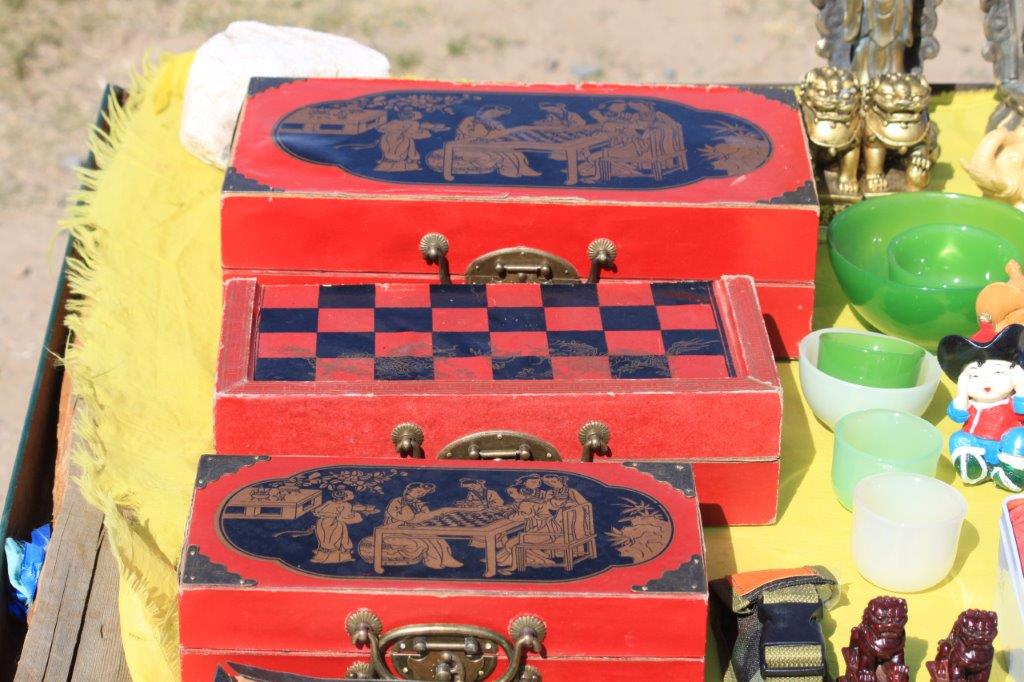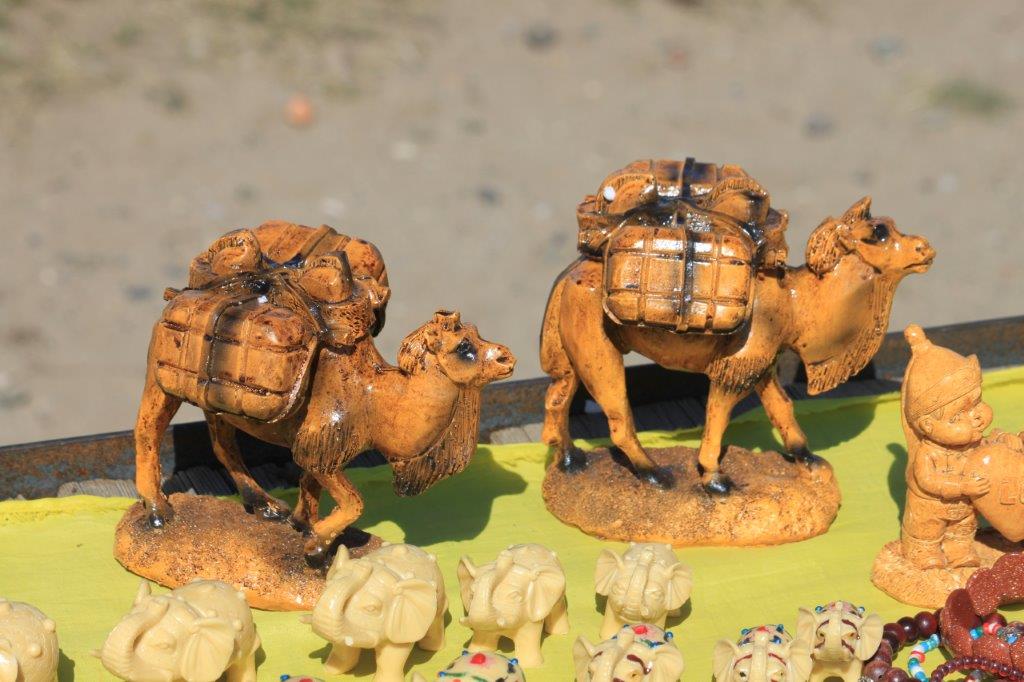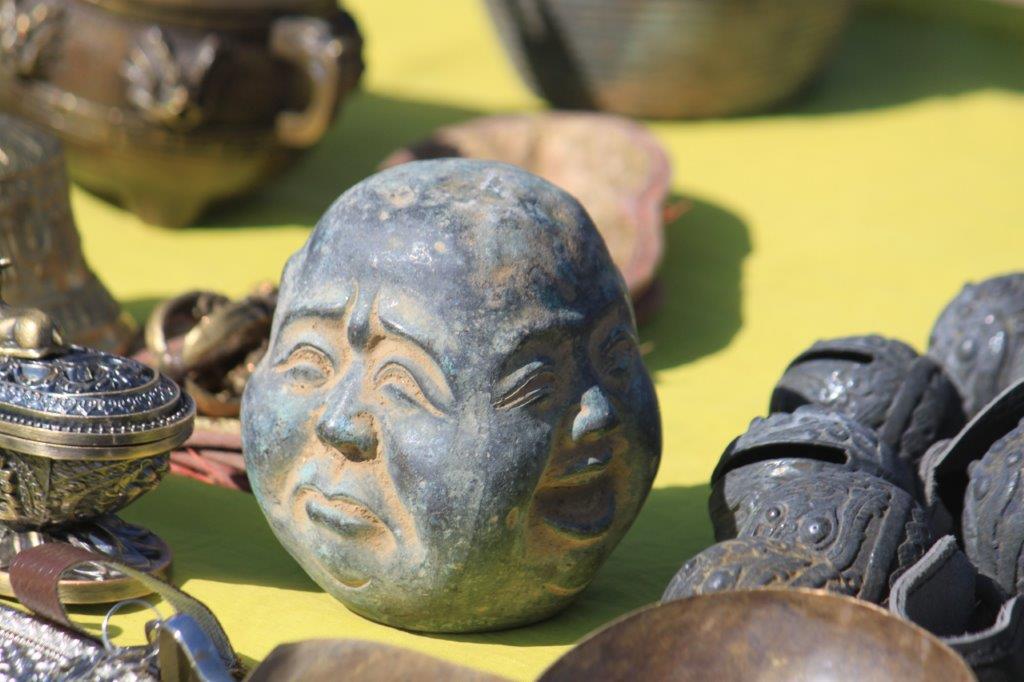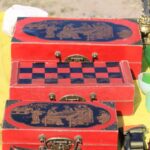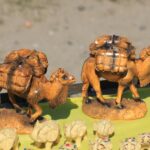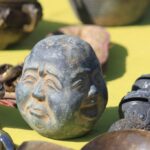Some History of Mongolia, Eagle Hunters and Genghis Khan at Karakorum
Khazak Eagle Hunters in Mongolia
I’ve always dreamt of meeting the famous Mongolian or better Kazakh Eagle hunters that lead their horse up a hill slope towards a ridge from where the view is without doubt incredible, first gazing upon the wide spread land in front of them, then looking slightly to the right where a large golden eagle rests, sitting upon their arms and they pull of a small cap, blinding the eagle, and then they throw it in the air and it swiftly and stealthily glides above the land toward a minute prey like a hare or a fox, catching it without blinking or hesitating even for a second. Than it immediately returns to the hunter, without taking a bite from the spoils…
Well that was not going to happen. These (Mongolian) Kazakh Eagle hunters live in the utmost west of Mongolia in the Bayan-Ölgii Province and The Wandelgek was not travelling that far into the country (although he had planned for quite an extensive roadtrip, Mongolia is really, really large), but there was the next best thing of holding a golden eagle on his arm…
Hunting with eagles is a traditional form of falconry found throughout the Eurasian Steppe, practised by ancient Mongolic and Turkic peoples. Today it is practised by Kazakhs and the Kyrgyz in contemporary Kazakhstan and Kyrgyzstan, as well as diasporas in Bayan-Ölgii Provinces Bayan-Ölgii, Mongolia, and Xinjiang, China. Though these people are most famous for hunting with golden eagles, they have been known to train northern goshawks, peregrine falcons, saker falcons, and more.
History
Khitans
In 936-45 AD the Khitans, a nomadic people from Manchuria, conquered part of north China. In 960 AD China was conquered by the Song dynasty. From its beginnings, the Song dynasty was unable to completely control the Khitan who had already assimilated much of Chinese culture. Throughout its 300-year rule of China, the Song dynasty had to pay tribute to the Khitan to keep them from conquering additional Song dynasty territory. Despite the fact that the Khitans assimilated Chinese culture, they retained many nomadic traditions, including eagle hunting.
Kyrgyz
In 1207, the Kyrgyz nomads surrendered to Genghis Khan’s son Jochi. Under Mongol rule, the Kyrgyz preserved their nomadic culture as well as eagle falconry traditions. Archaeologists trace back falconry in Central Asia to the first or second millennium BC.
Kazakhs
During the communist period in Kazakhstan, many Kazakhs fled for Mongolia to avoid being forced to abandon their nomadic lifestyle and sent to collective farms. They settled in Bayan-Ölgii Province and bringing with them their tradition of hunting with eagles. There are an estimated 250 eagle hunters in Bayan-Ölgii, which is located in the Altai Mountains of western Mongolia. Their falconry custom involves hunting with golden eagles on horseback, and they primarily hunt red foxes and corsac foxes. They use eagles to hunt foxes and hares during the cold winter months when it is easier to see the gold colored foxes against the snow. Each October, Kazakh eagle hunting customs are displayed at the annual Golden Eagle Festival. Although the Kazakh government has made efforts to lure the practitioners of these Kazakh traditions back to Kazakhstan, most Kazakhs have remained in Mongolia.
The Golden Eagle
The golden eagle (Aquila chrysaetos) is one of the best-known birds of prey in the Northern Hemisphere. It is the most widely distributed species of eagle. Like all eagles, it belongs to the family Accipitridae. These birds are dark brown, with lighter golden-brown plumage on their napes. Immature eagles of this species typically have white on the tail and often have white markings on the wings. Golden eagles use their agility and speed combined with powerful feet and massive, sharp talons to snatch up a variety of prey, mainly hares, rabbits, and marmots and other ground squirrels. Golden eagles maintain home ranges or territories that may be as large as 200 km2 (77 sq mi). They build large nests in cliffs and other high places to which they may return for several breeding years. Most breeding activities take place in the spring; they are monogamous and may remain together for several years or possibly for life. Females lay up to four eggs, and then incubate them for six weeks. Typically, one or two young survive to fledge in about three months. These juvenile golden eagles usually attain full independence in the fall, after which they wander widely until establishing a territory for themselves in four to five years.
The Mongol Empire
Those, like The Wandelgek, that dwell nowadays through the vast and empty spaces of Mongolia, will probably not have a clue that this once was the heartland of the largest contiguous empire ever on our planet. Yes it was much bigger than more well known empires, like that of Alexander the Great and the Roman Empire at its peak.
But as any great Empire, it started humble and small and began its growth after the Great Kahn united all Mongol tribes. This Great Kahn bore the name of Temujin, but the world got to know and fear him as Genghiz Kahn.
The Mongol Empire of the 13th and 14th centuries was the largest contiguous land empire in history and the second largest empire by landmass, second only to the British Empire (which was divided all over the planet and separated by large seas and oceans). Originating in Mongolia in East Asia, the Mongol Empire eventually stretched from Eastern Europe and parts of Central Europe to the Sea of Japan, extending northward into parts of the Arctic; eastward and southward into the Indian subcontinent, Mainland Southeast Asia and the Iranian Plateau; and westward as far as the Levant and the Carpathian Mountains.
This movie shows how the Empire grew between 1206 and 1294:
The Mongol Empire emerged from the unification of several nomadic tribes in the Mongol homeland under the leadership of Genghis Khan (c. 1162–1227), whom a council proclaimed as the ruler of all Mongols in 1206. The empire grew rapidly under his rule and that of his descendants, who sent out invading armies in every direction. The vast transcontinental empire connected the East with the West, the Pacific to the Mediterranean, in an enforced Pax Mongolica, allowing the dissemination and exchange of trade, technologies, commodities and ideologies across Eurasia.
The empire began to split due to wars over succession, as the grandchildren of Genghis Khan disputed whether the royal line should follow from his son and initial heir Ögedei or from one of his other sons, such as Tolui, Chagatai, or Jochi. The Toluids prevailed after a bloody purge of Ögedeid and Chagataid factions, but disputes continued among the descendants of Tolui. A key reason for the split was the dispute over whether the Mongol Empire would become a sedentary, cosmopolitan empire, or would stay true to the Mongol nomadic and steppe-based lifestyle. After Möngke Khan died (1259), rival kurultai councils simultaneously elected different successors, the brothers Ariq Böke and Kublai Khan, who fought each other in the Toluid Civil War (1260–1264) and also dealt with challenges from the descendants of other sons of Genghis. Kublai successfully took power, but civil war ensued as he sought unsuccessfully to regain control of the Chagatayid and Ögedeid families.
City of Karakorum (Genghis’ capital)
Next to the current monastery of Erdene Zuu, were the ruins of the once mighty city of Karakorum, the capital of Genghis Khan’s Mongol Empire, from where he ruled.
Karakorum was the capital of the Mongol Empire between 1235 and 1260 and of the Northern Yuan in the 14–15th centuries. Its ruins lie in the northwestern corner of the Övörkhangai Province of Mongolia, near today’s town of Kharkhorin and adjacent to the Erdene Zuu Monastery, the probable earliest surviving Buddhist monastery in Mongolia. They are part of the upper part of the World Heritage site Orkhon Valley.
History of the city
The Orkhon valley was a center of the Xiongnu, Göktürk, and Uyghur empires. To the Göktürks, the nearby Khangai Mountains had been the location of the Ötüken, and the Uyghur capital Karabalgasun was located close to where later Karakorum would be erected (downstream the Orkhon River 27 km north–west from Karakorum). This area is probably also one of the oldest farming areas in Mongolia.
In 1218–19, Genghis Khan rallied his troops for the campaign against the Khwarezm Empire in a place called Karakorum, but the actual foundation of a city is usually said to have occurred only in 1220. Until 1235, Karakorum seems to have been little more than a yurt town; only then, after the defeat of the Jin empire, did Genghis’ successor Ögedei erect walls around the place and build a fixed palace.
Ögedei Khan gave the decree to build the Tumen Amgalan Ord (Palace of Myriad Peace, Wan’an’gong in Chinese) in 1235 the year after he defeated the Jin Dynasty. It was finished in one year. In the History of Yuan (元史) it is written in the section for Taizong (太宗) Ögedei Khan: “In the seventh year (1236), in the year of the blue sheep the Wanangong (萬安宮) was established in Helin (和林, Karakorum).” One of Genghis Khan’s nine ministers the Khitan Yelü Chucai (1190–1244) said the following poem during the ridge raising ceremony of the Tumen Amgalan Ord: “Installed ridge well fit and stone foundation, The parallel placed majestic palace has been raised, When the bells and drums of the Lord and officials sound pleasantly, The setting sun calls the horses of war to itself from the mountain peaks.” The Mongolian version of the poem is as follows: “Tsogtslon tavih nuruu chuluun tulguur, Zeregtsen zogsoh surleg asriig bosgovoi, Ezen tushmediin honh hengereg ayataihan hanginan duursahad, Echih naran uuliin tolgoigoos dainii agtadiig ugtnam.
The name Karakorum or “Kharkhorin” literally translates to ‘black-twenty’. But linguists argue that the ‘khorin’ might have been a diversion of the word ‘khurem’, which means “castle” in Mongolian. Other translations vary.
Karakorum on the Silk Road

The Silk Road: somewhere in the midst of the stretch between Noin Ula in northern Mongolia and Khara-Khoto in China, was the ger campsite of Ghengis Khan, that became the city of Karakorum. The city of Khara-Khota was located on the crossroads connecting Karakorum, Shangdu and Kumul.
Karakorum (or the Karakorum and occasionally spelled Kharakhorum or Qara Qorum) was the capital city for the great Mongol leader Genghis Khan and, according to at least one scholar, the single most important stopping point on the Silk Road (more of other locations on the Silk Road that The Wandelgek visited can be found by clicking the link and through this map of the Silk Road) in the 12th and 13th centuries CE.
Prosperity
Under Ögedei and his successors, Karakorum became a major site for world politics. Möngke Khan had the palace enlarged, and the great stupa temple completed. They had the Parisian goldsmith, Guillaume Bouchier, design the Silver Tree of Karakorum for the city center. A large tree sculpted of silver and other precious metals rose up from the middle of the courtyard and loomed over the palace, with the branches of the tree extended into the building. Silver fruit hung from the limbs and it had four golden serpents braided around the trunk, while within the top of the tree was placed a trumpet angel, all as automata performing for the emperor’s pleasure. When the khan wanted to summon the drinks for his guests, the mechanical angel raised the trumpet to his lips and sounded the horn, whereupon the mouths of the serpents began to gush out a fountain of alcoholic beverages into the large silver basin arranged at the base of the tree.
William of Rubruck
William of Rubruck, a Flemish Franciscan missionary and papal envoy to the Mongols reached Karakorum in 1254. He has left one of the most detailed, though not always flattering, accounts of the city. He compared it rather unfavorably to the village of Saint-Denis near Paris, and was of the opinion that the royal abbey there was ten times as magnificent as the Khan’s palace. On the other hand, he also described the town as a very cosmopolitan and religiously tolerant place, and the silver tree he described as part of Möngke Khan’s palace as having become the symbol of Karakorum. He described the walled city as having four gates facing the four directions, two quarters of fixed houses, one for the “Saracenes” and one for the “Cathai”, twelve pagan temples, two mosques, as well as a Nestorian church.
Later times
When Kublai Khan claimed the throne of the Mongol Empire in 1260—as did his younger brother, Ariq Böke—he relocated his capital to Shangdu, and later to Khanbaliq (Dadu, today’s Beijing). Karakorum was thence reduced to a mere administrative center of a mere provincial backwater of the Yuan dynasty that was founded in China in 1271. Furthermore, the ensuing Toluid Civil War with Ariq Böke and a later war with Kaidu deeply affected the town. In 1260, Kublai disrupted the town’s grain supply, while in 1277 Kaidu took Karakorum, only to be ousted by Yuan troops and Bayan of the Baarin in the following year. In 1298–99 prince Ulus Buqa looted its markets and the grain storehouses. However, the first half of the 14th century proved to be a second era of prosperity: in 1299, the town had been expanded eastwards, then in 1311, and again from 1342 to 1346, the stupa temples were renewed.
The archaeological site
There were some large billboard like panels, explaining a lot about the site…
Life in Karakorum
The written sources mention not only a Chinese workshop area but also a Muslim quarter that was a market quarter and the meeting place for salesmen. Because of the location near to the Silk Road, the city attracted a lot of merchants of varying origins. Not all the inhabitants of Karskorum lived freely in the city, some of them – for example the French silversmith Guillaume Boicher – had been taken prisoner during military expeditions by the Mongols and has to serve the Khans.
The cruel Mongolian politics of conquest are in strong contrast to the great religious tolerance of the rulers, which becomes apparent in their capital Karakorum. After his visit to the court of Möngke Khan in 1254/53 the Flemish monk William of Rubruk reports that two mosques, a Christian church and twelve “idol temples” existed in Karakorum.
But the city of Karakorum was not only a religious centre, a trading point near the Silk Road and a centre of administration. As the capital of a nomadic empire, the city also served as a storage place for tribute payments and spoils.

Left: Silver coin with Arabic script (find spot: vessel deposit Great Hall.
Right: Golden coin with the symbol of Genghis Khan (Find spot: Vessel deposi6t Great Hall
The decline of Karakorum
Because of increasing internal disputes about the leadership of the empire, the freshly nominated Kublai Khan initiated the displacement of the capital to Dadu (Beijing) in 1260 and thus established the Yuan dynasty in China. Archaeological finds attest that the city of Karskorum still enjoyed great importance, despite the loss of its function as capital.
In the subsequent period the conflicts beteeen Kublai and his enemies were continuously rekindled. During this period and after the removal of the Mongolian Yuan dynasty from China in 1368, Karakorum was repeatedly the theatre of military operations. The definite decline of the former capital started during the 16th century.
During the contruction of the Erdene Zuu monastery the abandoned city was used as a stone quarry ans architectural elements originated from Karakorum can still be found in the monastery complex today.
The excavations carried out by the MDKE at the outer walls and the gates of the Erdene Zuu monastery highlight the fact that the former capital and tge monastery were closely connected. The excavations below the walls and the gates revealed building features that could be dated to the Early Mongolian period. They possibly indicate the not yet identified palace of the Mongolian Khans.
Some remnants were found of the foundations of
The Great Hall
The interpretation of the archaeological finds
The remains of lotus thrones in each corner of the central space and a great number of fragments stemming from reliefs and figurines indicate, in addition to the tsa-tsas, a Buddhist context. The Great Hall should therefore be interpreted as being an important Buddhist temple rather than the Kahn’s palace. Today it is assumed that the Kahn’s palace was located in the area of the cloister garth of the Erdene Zuu monastery.
Next to a Nestorian-Christian church there were two mosques and several other “pagan'” temples as reported by the Franciscan monk William of Rubruk. This record supports the interpretation of Karakorum as a religious centre.
The Great Hall most probably corresponds to the “temple of the rise of the Yuan” mentioned in the Sino-Mongolian inscription of 1346, which was erected on the occasion of the temple’s renovation. This inscription describes the temple as being a seven-nave building.

Attempt to reconstruct the Great Hall with a central stupa, the Chinese framework and roof construction as well as an attempt to reconstruct the configuration of the temple complex
Attempt to reconstruct the Great Hall
To a lesser extent the temple also mirrors the merging of various cultural influences with regard to its planning and construction that were particularly specific of the Mongolian capital.
The configuration of the ground plan with four pathways leading to a centre can be interpreted as the architectural implementation of a Tibetan mandala whereas the roof construction can be located in the Chinese area.
Seventy wooden columns supported a roof covered with tiles that was probably curved and multi-layered as are the Chinese examples. The eccavated wall remains make it posdible to assume a wooden skeleton structure.
The area adjacent to the Great Hall
In addition to the central relief, corresponding to the Buddhist temple, the relief map evidences six additional elevations grouped around the Great Hall that contain further construction remains. Although these buildings were only partially uncovered and their function is still unclear, these were probably small prayer rooms as well as living and storage rooms associated with the temples.
13th century Stone Turtle(s)
These stone turtles indicate where the borders of ancient Karakorum were.
Strolling through the grass of the huge empty site, where the city had been, he suddenly noticed a flat stone, which looked more like a tablet then like a stone. It carried markings and the guide explained that the site was full of these just lying around in the grass or underneath the soil. These were remnants of the city…
 The Wandelgek found it quite hard to believe that so little was left of what once must have been a place of splendour. I mean, this was Genghis’ and Ogodei’s capital, from where they governed the mightiest emoire on Earth and where they collected artisans from all over their empire to ….
The Wandelgek found it quite hard to believe that so little was left of what once must have been a place of splendour. I mean, this was Genghis’ and Ogodei’s capital, from where they governed the mightiest emoire on Earth and where they collected artisans from all over their empire to ….
Research
The excavations carried out at Karakorum
Since 2000 excavations have been carried out at distinct points in the city area of Karakorum and the cloister of the Erdene Zuu monastery as well as the outer walls. In addition to the archaeological investigation of the so-called Great Hall and the adjecent kiln site the German Archaeological Institute, as part of the MDKE, also uncovered a building complex in the northern part of the city that could be interpreted as being a religious complex.
The research carried out by the MDKE of the University of Bonn during the excavation campaigns from 2000 to 2005 focussed on the imvestigation of the features located at the centre of the grid plan.
In this area the cobbled paving and the buildings can be assigned to several construction phases, of which the earliest one can be assigned to the foundation period of Karakorum, traditionally dated to the first half of the 13th century.
The discovery of the Chinrse roof tiles and architectural elements makes it posdible to assume that we are dealing with the Chinese quarter reported by the Franciscan monk William of Rubruk. Moreover, as is attested to by written sources, this quarter was ocvupied by craftsmen, which is confirmed by the discovery of traces indicating the processing of metal, bone and glass / precious stones.
The kiln and workshop areas on the Orkhon river side
Two sites, located on the right as well as on the left river terrace of the Orkhon river near to the modern city of Kharkhorin show that it is also important to study the environment of Karakorum in order to realise the comprehensive investigation of the ancient urban structures. At both sites the excavations carried out by the MDKE uncovered kiln areas associated with workshops. The site on the right side of the Orkhon river was excavated over an area encompassing 760 m2 and it yielded 24 kilns in total, including several Chinese kiln types. They were used not only for the firing of roof tiles for local needs but also for the serial production of architectural decoration and clay figurines.
On a hill outside the monastery sits a stone phallus called Kharkhorin Rock. The phallus is said to restrain the sexual impulses of the monks and ensure their good behavior.?
There were some souvenir stalls too…
After a short visit, searching for a Buddhist book wrapped in bright cloth, I asked my guide whether such a book was available and for sale. I already owns two books which were both from Nepal, but they were both not wrapped in cloth like the ones that lie in monasteries. My guide told me he knew an address in Ulaanbaatar. I decided to ask him again when we would arrive there.
It was time to get on the road again…






























